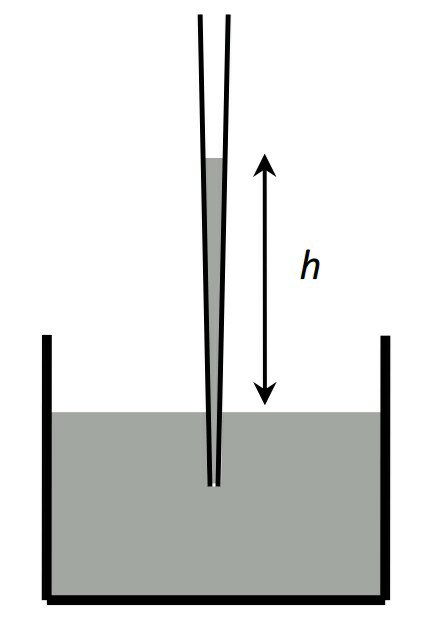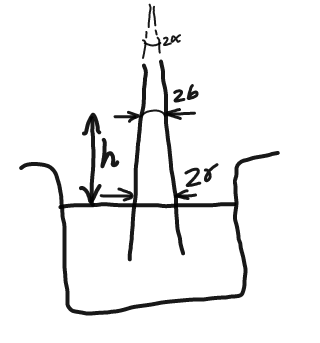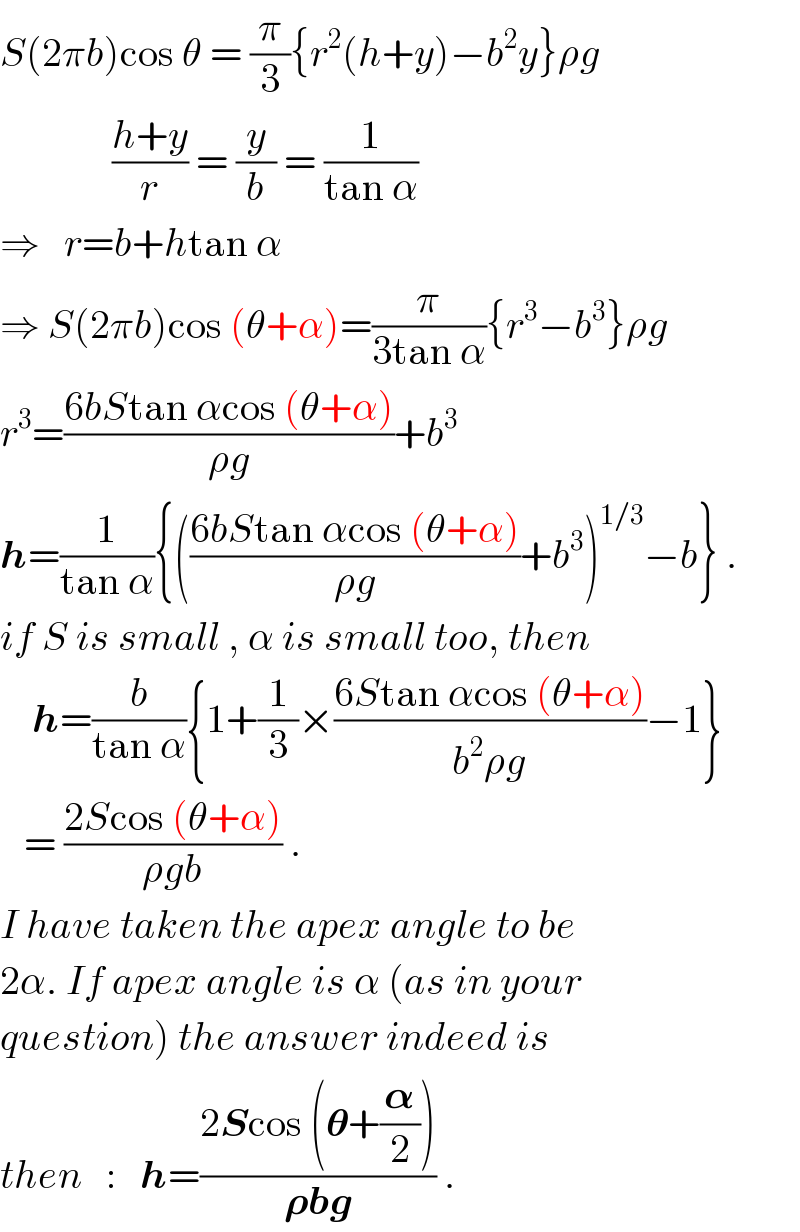Question Number 35124 by Tinkutara last updated on 15/May/18

Commented by Tinkutara last updated on 15/May/18

$${It}\:{contains}\:{no}\:\alpha? \\ $$
Commented by Tinkutara last updated on 15/May/18

Commented by ajfour last updated on 15/May/18

Commented by ajfour last updated on 16/May/18

$${S}\left(\mathrm{2}\pi{b}\right)\mathrm{cos}\:\theta\:=\:\frac{\pi}{\mathrm{3}}\left\{{r}^{\mathrm{2}} \left({h}+{y}\right)−{b}^{\mathrm{2}} {y}\right\}\rho{g} \\ $$$$\:\:\:\:\:\:\:\:\:\:\:\:\:\:\frac{{h}+{y}}{{r}}\:=\:\frac{{y}}{{b}}\:=\:\frac{\mathrm{1}}{\mathrm{tan}\:\alpha} \\ $$$$\Rightarrow\:\:\:{r}={b}+{h}\mathrm{tan}\:\alpha \\ $$$$\Rightarrow\:{S}\left(\mathrm{2}\pi{b}\right)\mathrm{cos}\:\left(\theta+\alpha\right)=\frac{\pi}{\mathrm{3tan}\:\alpha}\left\{{r}^{\mathrm{3}} −{b}^{\mathrm{3}} \right\}\rho{g} \\ $$$${r}^{\mathrm{3}} =\frac{\mathrm{6}{bS}\mathrm{tan}\:\alpha\mathrm{cos}\:\left(\theta+\alpha\right)}{\rho{g}}+{b}^{\mathrm{3}} \\ $$$$\boldsymbol{{h}}=\frac{\mathrm{1}}{\mathrm{tan}\:\alpha}\left\{\left(\frac{\mathrm{6}{bS}\mathrm{tan}\:\alpha\mathrm{cos}\:\left(\theta+\alpha\right)}{\rho{g}}+{b}^{\mathrm{3}} \right)^{\mathrm{1}/\mathrm{3}} −{b}\right\}\:. \\ $$$${if}\:{S}\:{is}\:{small}\:,\:\alpha\:{is}\:{small}\:{too},\:{then} \\ $$$$\:\:\:\:\boldsymbol{{h}}=\frac{{b}}{\mathrm{tan}\:\alpha}\left\{\mathrm{1}+\frac{\mathrm{1}}{\mathrm{3}}×\frac{\mathrm{6}{S}\mathrm{tan}\:\alpha\mathrm{cos}\:\left(\theta+\alpha\right)}{{b}^{\mathrm{2}} \rho{g}}−\mathrm{1}\right\} \\ $$$$\:\:\:=\:\frac{\mathrm{2}{S}\mathrm{cos}\:\left(\theta+\alpha\right)}{\rho{gb}}\:. \\ $$$${I}\:{have}\:{taken}\:{the}\:{apex}\:{angle}\:{to}\:{be} \\ $$$$\mathrm{2}\alpha.\:{If}\:{apex}\:{angle}\:{is}\:\alpha\:\left({as}\:{in}\:{your}\right. \\ $$$$\left.{question}\right)\:{the}\:{answer}\:{indeed}\:{is} \\ $$$${then}\:\:\::\:\:\:\boldsymbol{{h}}=\frac{\mathrm{2}\boldsymbol{{S}}\mathrm{cos}\:\left(\boldsymbol{\theta}+\frac{\boldsymbol{\alpha}}{\mathrm{2}}\right)}{\boldsymbol{\rho{bg}}}\:. \\ $$
Commented by Tinkutara last updated on 16/May/18
Answer given is dependent on alpha.
Commented by ajfour last updated on 16/May/18

$${post}\:{the}\:{answer}\:{please}. \\ $$
Commented by Tinkutara last updated on 16/May/18
Question from JEE Advanced 2014.
Commented by ajfour last updated on 16/May/18

$${i}\:{compared}\:{the}\:{capillary}\:{in}\:{the} \\ $$$${diagrams}\:{now}\:{only},\:{sorry}\:{for} \\ $$$${the}\:{reverse}\:{orientation},\:{however} \\ $$$${my}\:{answer}\:{for}\:\boldsymbol{{h}}\:{is}\:{the}\:{same}\:! \\ $$
Commented by Tinkutara last updated on 16/May/18
I appreciate your solution Sir!
